Scientific American, Volume XXIV., No. 12, March 18, 1871 by Various, is part of the HackerNoon Books Series. You can jump to any chapter in this book here. KNOTS AND SPLICES.
KNOTS AND SPLICES.
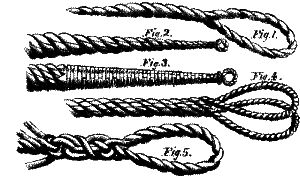
1. Turn used in making up ropes.
-
End tapered for the purpose of passing it readily through a loop. To make this, we unlay the rope for the necessary length, reducing a rope diminishing in diameter towards the end, which is finished by interlacing the ends without cutting them, as it would weaken the work; it is lastly "whipped" with small twine.
-
Tapered end, covered with interlaced cordage for the purpose of making it stronger. This is done with very small twine attached at one end to the small eye, and at the other to the strands of the rope, thus making a strong "webbing" around the end.
-
Double turn used for making rope.
-
Eye splice. The strands of the cable are brought back over themselves, and interlaced with their original turns, as in a splice.
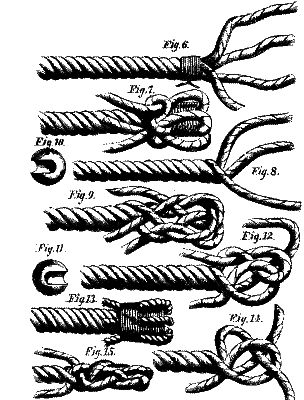
6. Tie for the end of a four-strand rope.
-
The same completed; the strands are tied together, forming loops, laying one over the other.
-
Commencement for making the end by interlacing the strands.
-
Interlacing complete, but not fastened.
10 and 11. Shell in two views used in No. 65, showing the disposition of it at the throat. This joining is advantageous, as it does not strain the cords, and it prevents them from cutting each other; so that the rings pass one into the other and are joined outside the intermediate shell.
-
Interlacing in two directions.
-
Mode of finishing the end by several turns of the twine continued over the cable.
-
Interlacing commenced, in one direction.
-
Interlacing finished, the ends being worked under the strands, as in a splice.
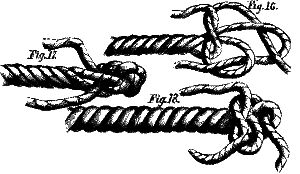
16. Pigtail commenced.
17. Interlacing fastened.
18. Pigtail with the strands taut.

19. Dead eye, shown in two views.

20. Pigtail finished. We pass the ends of the strands, one under the other, in the same way as if we were making a pudding splice: thus bringing it in a line with the rope, to which it is seized fast, and the ends cut off.

21. Scull pigtail; instead of holding the ends by a tie, we interlace them again, as in No. 16, the one under the other.
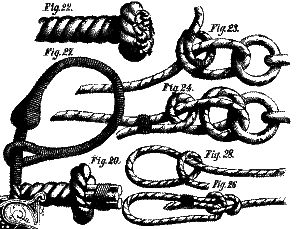
22. Pigtail, or "lark's nest." We make this to the "pennant" of a cable, which has several strands, by taking the requisite number of turns over the pudding, in such a manner that the strands shall lay under each other. This "pigtail" forms a knot at the end of the rope. It thus draws together two ropes, as shown in No. 32, forming a "shroud" knot. In these two pigtails, the strands are crossed before finishing the ends, so that the button, a, is made with the strands, a, and b, with those of the rope, b.
23. Slip clinch to sailors' knot.
24. Slip clinch, secured.

25. Ordinary knot upon a double rope.
26. Bowline knot for a man to sit in at his work.
27. Called a "short splice," as it is not of great length, and besides, can be made quickly.

30. Long splice. This extends from a to b. We unlay the strands of each of the ropes we intend to join, for about half the length that the splice will be, putting each strand of the one between two strands of the other.
31. Simple fastening on a rope.
32. A "shroud" knot.
33. The ends of the rope are prepared for making the splice (No. 29) in the same manner as for the "shroud" knot in No. 32. When the strands are untwisted, we put the ends of two cords together as close as possible, and place the ends of the one between the strands of the other, above and below alternately, so as to interlace them as in No. 29. This splice is not, however, very strong, and is only used when there is not time to make a long splice, which is much the best.
34 and 35. Marline spikes. Tools made of wood or iron, used to open out a rope to pass the strands of another through it.
36. Shows strands arranged as described in No. 30.
37. Fastening when a lever is used, and is employed when hauling upon large ropes, where the strength of several men are necessary.
38. A "pudding splice." This is commenced, like the others, by placing the rope end to end, the turns of the one being passed between those of the other; having first swelled out the yarns by a "rat's-tail," we put them, two by two, one over the other, twisting them tightly, and opening a way for them with the marlinspike. The inconvenience of this splice is, that it is larger in diameter than the rope itself; but when made sufficiently long, by gradually reducing the size of the strands, it has great strength.
39. This shows two strands, a and b, of the ropes, A B, knotted together, being drawn as tight as possible; we unlay the strand, a', of the rope, A, for half the length of the splice, and twist the strand, b', of the rope, B, strongly in its place, tying a' and b' together tightly. The same process is again gone through on the rope, B, the strand, a", of the rope, A, being knotted to the strand, b", of the rope, B. When all the strands are thus knotted together, we interlace them with the strands of the cable. Thus the strands, a a' a", are interlocked by being passed alternately above and below the turns of the cord, B, the ends being also sometimes "whipped." In the same manner the strands, b b' b", pass alternately over and under the strands of the rope, A, and are in like manner "whipped." It is important that the several interlacings and knots should not meet at one point; we reduce the size of the strands towards the end, so that they loose themselves in the body of the splice, cutting off such parts as may project. This splice is employed for joining the ends of a rope when a chafed part has been cut out, and is quite as strong as the rope itself.
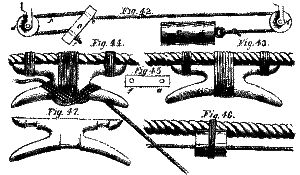
40. Belaying-pin opened to serve as a button; these are used where it is necessary to stop or check velocity.
41. Chain knot, or fastening.
42. Variable or regulating lashing. By laying the piece, a f, horizontally, it can be slipped along the rope, b; by raising or lowering this, we shall raise or depress the weight, c, the cord, b, running over the two pulleys, d, from the piece, a f, in the direction shown in the figure. The friction of the cord, b, passing through the hole, e, sufficiently fixes the piece, a f, and holds the weight, c, securely.
43. Cleet, with three ties.
44. Cleet, showing the mode of belaying the cord.
45. The piece, a f, of No. 42.
46. Fair leader.

47. Cleet to be fixed to a stay.
48. Loop for slipping other lines.
49. A "bend" which is only used for fear of the stoppers snapping.
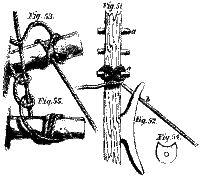
50. Bastard loop, made on the end of the rope, and whipped with yarns.
51. Tie to pins: a, the pin; b, small cords fixed by a cross tie.
52. Cleet, fixed to the "rail," either with screws or nails, to which the lines are belayed.
53. Waterman's knot.
54. Fair leader.
55. Tie, or bend to pier.

56. Simple fastening to tie.
57. Fastening by a loop. This can be tied or untied without loosening the loop itself. It is made by following, towards the longer loop, the direction as numbered 1, 2, 3, 4, 5, and is terminated by the loop, 6, 7, 6, finally passing it over the head of the post, A. This knot holds itself, the turns being in opposite directions. To untie it, we slack the turns of the cable sufficiently to again pass the loop, 6, 7, 6, over the post, A, and turn the ends in the contrary direction to that in which they were made (as 5, 4, 3, 2, 1).

58. Iron "shell," in two views.

59 and 60. "Wedding" knots; a b, eyelets; c d, the join; e, the fastening.

- Lark's-head fastening to running knot.

-
A round turn; the cord, a, is passed through the bight of the cord, b, over the button, c, where it is secured by an ordinary knot.
-
Belaying-pin splice. The cord, b, "stops" the pin, e, its end being spliced upon itself, and "served" with yarn; this rope, with its pin, is passed through the spliced eye, f of the line, g.

64. Round button.
65. Joint by a spherical shell, each loop, a and b, being made by ties and splices, and surrounding the shell, c.

- Belaying-pin, shown separately, before being stoppered.

-
Fastening to shears.
-
Square mooring. When the cable is round the post, A, and the piece, c, without being crossed, it lays in the section 1, 2, 3, 4, 5, 6, 7, and the end is fastened by tying.
- Crossed fastening. The turns of the cable, passing in front of the post, B, are crossed at the back of C, in the direction 1, 2, 3, 4, 5, 6, 7, 8, the end, 8, being secured to the cable

- Wooden shell in section.
- Wooden shell.

- Double-chain fastening.

73. Lashing for "ram" block, or "dead-eye." The ram blocks, a and b, are strapped by the cords, e, which hold them; the small lanyards, d, pass through the holes to make the connection, and as they are tightened give the requisite tension to the cordage; the ends are fastened to the main rope. Usually one of these dead-eyes is held by an iron strap to the point where it is required to fix and strain the cordage, which is ordinarily a shroud.
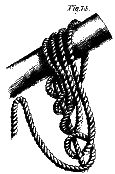
- Chain fastening.

1'. Simple band, showing the upper side.
2'. The same, showing the under side and the knot.
3'. Tie, with crossed ends, commenced; a turn is taken under the strands, to hold the ends of the cord.
4'. The same, completed.
5'. Bend with crossed strands, commenced, the one end being looped over the other.
6'. The same, completed.
7'. Necklace tie, seen on the upper side.
8'. The same, seen underneath. The greater the strain on the cords, the tighter the knot becomes.
9' and 10' are similar splices to 7' and 8' with slight modifications.
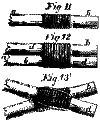
11' shows the commencement of 13', the legs in elevation; 12' being a front view. An ordinary band, made by several turns of a small rope, is lapped round them and hauled taut, and then interlaced at the ends. This done, the legs are shifted into the shape of a St. Andrew's cross. Thus the lashing is tightened, and, for further security, we pass the line several times over the tie and between the spars, knotting the ends.
13'. Portuguese knot. This is a lashing for shear legs, and must be tight enough to prevent the spars slipping on each other; the crossing of the two legs gives a means of securing the knot.

14'. For binding timbers; a, knot commenced. Take several turns round the timbers, and fasten the ends by passing them under the turns; b, knot completed. The end of a round stick, m n, termed a packing stick, should be passed under the knob, the cord being slack enough to allow of this. By turning the stick, the turns can be tightened to any extent; when tight, we fasten the longer arm of the lever to some fixed point, by a rope, p q, so that it cannot fly back. Care must be taken not to turn the stick too far, or the rope may be broken. As the timber dries and shrinks, the lever may be used to make all taut again.
About HackerNoon Book Series: We bring you the most important technical, scientific, and insightful public domain books.
This book is part of the public domain. Various (2006). Scientific American, Volume XXIV., No. 12, March 18, 1871. Urbana, Illinois: Project Gutenberg. Retrieved https://www.gutenberg.org/cache/epub/19180/pg19180-images.html
This eBook is for the use of anyone anywhere at no cost and with almost no restrictions whatsoever. You may copy it, give it away or re-use it under the terms of the Project Gutenberg License included with this eBook or online at www.gutenberg.org, located at https://www.gutenberg.org/policy/license.html.

